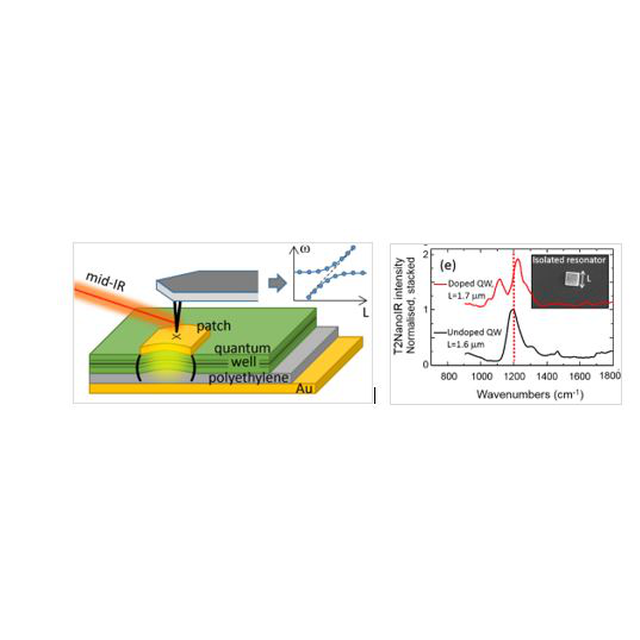Researchers at C2N, in collaboration with University of Rome (Italy), Istituto Italiano di Technologia (Italy), Rice University (USA) and University Leeds (UK), have demonstrated an original nanospectroscopy technique that permits the study of the light−matter interaction in single subwavelength-sized nanocavities.
When it comes to optical characterization of single objects in the mid-IR spectral range, optical setups and detectors traditionally lack the necessary signal-to-noise ratio. Far field measurements (such as FTIR spectroscopy) require a relatively big number of optical elements, while near field techniques (such as SNOM microscopy) yield sometimes noisy results. Clean, unambiguous spectra – especially when studying cavity resonators, where the fields are buried inside the optically active material – are a challenge when dealing with isolated structures.
In this work, achieved through a joint effort between C2N and La Sapienza University of Rome, in collaboration with Rice University (USA) and University Leeds (UK), a new near-field approach to optically characterize concealed metal-insulator-metal structures at the single-resonator level has been introduced. The principle relies on the insertion of a thin layer of polyethylene, that has a large transparency window in the mid-IR spectral region, inside a metal-insulator-metal cavity resonator hosting a semiconductor quantum well in its core. Such quantum well exhibits an intersubband transition at around =8 μm.
When light from a laser source is focused on the sample it can be absorbed by the system, due to ohmic dissipation in the metal structures and electronic transitions in the quantum well. The dissipated power is locally transformed into heat at selected frequencies. Such heat diffuses into the polymer that – in turn - thermally expands. The entire structure thus swells along the vertical direction, and an AFM tip detects the change, and therefore the resonance which is at its origin. The polymer inside the resonator behaves as a thermal transducer.
Such technique has been applied to a particularly challenging case: an intersubband transition strongly coupled to the photonic cavity mode of a single resonator. In the strong light-matter coupling regime new states appear, called intersubband polaritons in this case, that in general are studied on arrays of hundreds of resonators. The developed innovative approach has allowed the typical anticrossing characteristic of the polaritonic dispersion to be identified in the cavity loss spectra at the single nanoresonator level instead. Researchers also showed that it is possible to map the fields buried inside the cavity resonator, that are otherwise inaccessible. This technique might be even more appealing in the THz region, where detectors suffer even poorer efficiency and studying optical properties on isolated structures is even more challenging.
References
Detection of Strong Light–Matter Interaction in a Single Nanocavity with a Thermal Transducer
M. Malerba1, S. Sotgiu2, A. Schirato3,4, L. Baldassarre2, R. Gillibert5, V. Giliberti5, M. Jeannin1, J-M Manceau1, L. Li6, A.G. Davies6, E.H. Linfield6, A. Alabastri7, M. Ortolani2,5, R. Colombelli1
ACS Nano 2022, 16, 12, 20141–20150
DOI : https://doi.org/10.1021/acsnano.2c04452
1 Centre de Nanosciences et de Nanotechnologies (C2N), CNRS UMR 9001, Université Paris Saclay,
10 Boulevard Thomas Gobert,91120 Palaiseau, France
2 Department of Physics, Sapienza University of Rome,
Piazzale Aldo Moro 5, 00185 Rome, Italy
3 Dipartimento di Fisica, Politecnico di Milano,
Piazza Leonardo da Vinci 32, 20133 Milan, Italy
4 Istituto Italiano di Tecnologia,
via Morego 30, 16163 Genoa, Italy
5 Center for Life NanoScience, Istituto Italiano di Tecnologia,
Viale Regina Elena 291, 00161 Rome, Italy
6 School of Electronic and Electrical Engineering, University of Leeds,
Woodhouse Lane, LS29JT Leeds, UK
7 Department of Electrical and Computer Engineering, Rice University, 6100 Main Street,
TX 77005 Houston, USA
Figure 1 – Left: Sketch of the T2NanoIR experimental and illumination scheme on a single nanocavity. Laser light impinging on the system is absorbed by the active region inside the patch cavity. Dissipation leads to thermal nano-expansion of the polyethilene layer that is inserted in the cavity. Such expansion is detected with a judiciously configured atomc force microscope (AFM).
Right: T2Nano-IR spectra of single nanocavities, in the case of an undoped (black curve) and doped (red curve) active region. The former reveals the bare cavity resonance, the latter reveals the two polariton branches.









